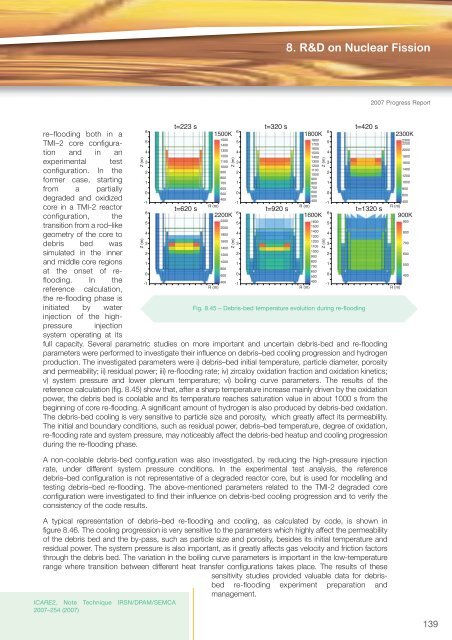Fusion Programme - ENEA - Fusione
Fusion Programme - ENEA - Fusione
Fusion Programme - ENEA - Fusione
- No tags were found...
You also want an ePaper? Increase the reach of your titles
YUMPU automatically turns print PDFs into web optimized ePapers that Google loves.
8. R&D on Nuclear Fission2007 Progress ReportZ (m)Z (m)6543210-16543210-1t=223 s t=320 s t=420 s661500K 1800K 2300K150014001300120011001000900800700600500400R (m)t=620 s t=920 s t=1320 s662200K 1600K 900K2200200018001600140012001000800600400R (m)re–flooding both in aTMI–2 core con figura -tion and in anexperimental testconfiguration. In theformer case, startingfrom a partiallydegraded and oxidizedcore in a TMI-2 reactorconfiguration, thetransition from a rod–likegeometry of the core todebris bed wassimulated in the innerand middle core regionsat the onset of reflooding.In thereference calculation,the re-flooding phase isinitiated by waterinjection of the highpressureinjectionsystem operating at itsfull capacity. Several parametric studies on more important and uncertain debris-bed and re-floodingparameters were performed to investigate their influence on debris–bed cooling progression and hydrogenproduction. The investigated parameters were i) debris–bed initial temperature, particle diameter, porosityand permeability; ii) residual power; iii) re-flooding rate; iv) zircaloy oxidation fraction and oxidation kinetics;v) system pressure and lower plenum temperature; vi) boiling curve parameters. The results of thereference calculation (fig. 8.45) show that, after a sharp temperature increase mainly driven by the oxidationpower, the debris bed is coolable and its temperature reaches saturation value in about 1000 s from thebeginning of core re-flooding. A significant amount of hydrogen is also produced by debris-bed oxidation.The debris-bed cooling is very sensitive to particle size and porosity, which greatly affect its permeability.The initial and boundary conditions, such as residual power, debris–bed temperature, degree of oxidation,re-flooding rate and system pressure, may noticeably affect the debris-bed heatup and cooling progressionduring the re-flooding phase.A non-coolable debris-bed configuration was also investigated, by reducing the high-pressure injectionrate, under different system pressure conditions. In the experimental test analysis, the referencedebris–bed configuration is not representative of a degraded reactor core, but is used for modelling andtesting debris–bed re-flooding. The above-mentioned parameters related to the TMI-2 degraded coreconfiguration were investigated to find their influence on debris-bed cooling progression and to verify theconsistency of the code results.Z (m)Z (m)543210-1543210-1R (m)1800170016001500140013001200110010009008007006005004001600150014001300120011001000900800700600500400R (m)Fig. 8.45 – Debris-bed temperature evolution during re-floodingZ (m)Z (m)543210-1543210-1200018001600140012001000800600400R (m)R (m)23002200900800700600500400A typical representation of debris–bed re-flooding and cooling, as calculated by code, is shown infigure 8.46. The cooling progression is very sensitive to the parameters which highly affect the permeabilityof the debris bed and the by-pass, such as particle size and porosity, besides its initial temperature andresidual power. The system pressure is also important, as it greatly affects gas velocity and friction factorsthrough the debris bed. The variation in the boiling curve parameters is important in the low-temperaturerange where transition between different heat transfer configurations takes place. The results of thesesensitivity studies provided valuable data for debrisbedre-flooding experiment preparation andmanagement.ICARE2, Note Technique IRSN/DPAM/SEMCA2007–254 (2007)139













